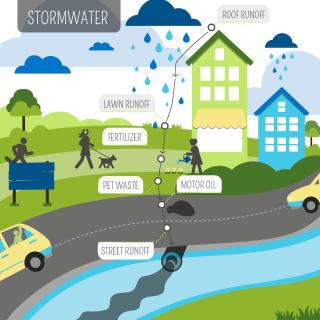Stormwater and Land Disturbance

Stormwater and Land Disturbance Bylaw: Chapter 193
Stormwater discharges are generated by runoff from land and impervious areas during rainfall and snow events. Stormwater picks up litter, sand, bacteria, oil and other chemicals as it flows over the land and it carries these pollutants to our streams, rivers, ponds and wetlands. Runoff from paved surfaces, such as roads, parking lots and rooftops, may contribute large amounts of polluted storm water. Cleaning up storm water not only benefits our neighborhoods and town, it also benefits the entire network of water bodies and land that make up our watershed (Sudbury-Assabet-Concord (SuAsCo) Watershed).
In Wayland, stormwater is regulated at the federal level by the Environmental Protection Agency (EPA), the state level by the Massachusetts Department of Environmental Protection (DEP) and at the town level it falls under the jurisdiction of the Wayland Wetlands and Water Resources Bylaw, Chapter 194, which is regulated by the Conservation Commission, and Chapter 193, Stormwater and Land Disturbance bylaw.
Chapter 193 Permit Application
- Application
- Submittal Requirements
- Filing Fee
- Replacement Planting Guidelines
- Bylaw
- A Guide to Rain Gardens
NOTE: Any activity within 100' of a wetland or 200' of a perennial stream or 200' of a floodplain is also under the jurisdiction of the Conservation Commision and requires their approval. The Conservation Commission is the sole board that can determine whether an area is or is not under their jurisdiction. To determine whether your property is within the Commission's jurisdiction, please contact the Conservation office.
MS4 Permits:
The US EPA and MassDEP require Municipalities with Separate Storm Sewer Systems (MS4s) in urbanized areas (through the National Pollutant Discharge Elimination Systems (NPDES) permit) to implement programs and practices to control polluted stormwater runoff. Wayland is regulated as a Phase II community. Phase II is intended to further reduce adverse impacts to water quality and aquatic habitat by instituting the use of controls on the unregulated sources of stormwater discharges that have the greatest likelihood of causing continued environmental degradation. For more information click here.
As authorized by the Clean Water Act, the National Pollutant Discharge Elimination System (NPDES) permit program controls water pollution by regulating point sources that discharge pollutants into waters of the United States. Point sources are discrete conveyances such as pipes or man-made ditches. Individual homes that are connected to a municipal system, use a septic system, or do not have a surface discharge do not need an NPDES permit; however, industrial, municipal, and other facilities must obtain permits if their discharges go directly to surface waters.

